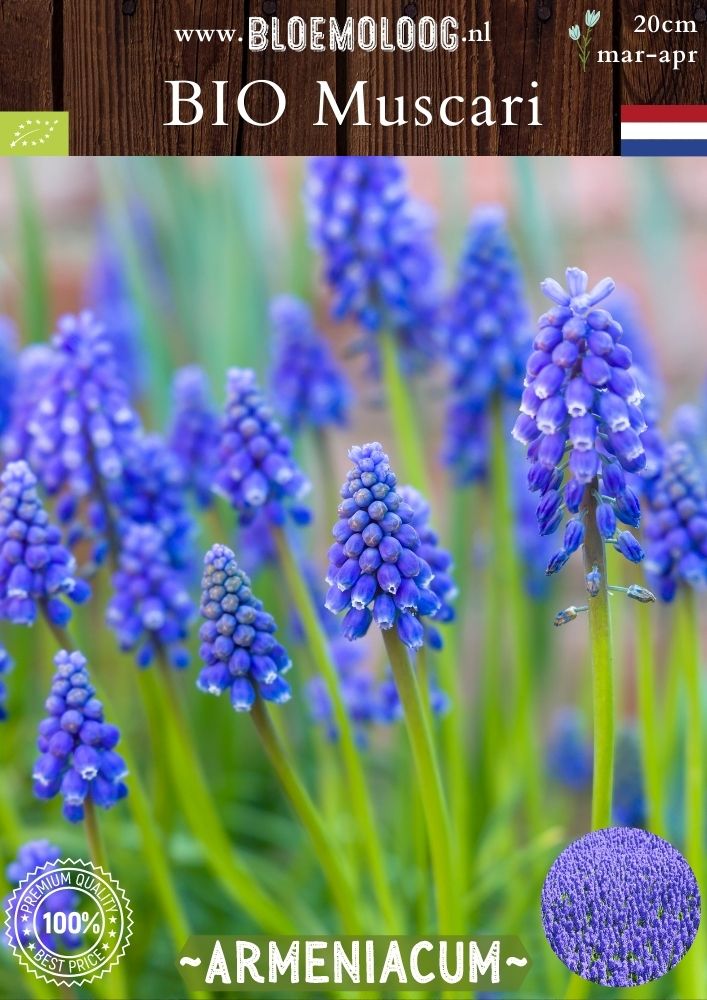Bloemoloog
Organic Muscari 'Armeniacum' - Grape hyacinth | 10 pcs.
Organic Muscari 'Armeniacum' - Grape hyacinth | 10 pcs.
Estimated Shipping Widget will be displayed here!
Couldn't load pickup availability
Organic blue grape hyacinth
The Muscari 'Armeniacum' is also knows as 'grape hyacinth'. It has striking spray flowers of small blue pearls in a conical shape. As it opens, the cone changes into a spherical cluster. The flowers contain a lot of nectar, which provides pollinators such as bees with a lot of food so early in the year.
The flower cluster blooms on top of the flower stem of about 20 centimeters high. It blooms in March and April with 3 to 5 flower stems per bulb and produces 3 to 5 bluish green narrow leaves per bulb that are higher than the flower.
How, where and when do I plant grape hyacinth flowerbulbs?
The muscari needs a cold period and should be planted in the ground from September to January. The correct planting depth varies between 2 to 3 times the height of the bulb itself, while the recommended planting distance is 2 to 3 times the width of the bulb.
Plant the flowerbulbs in a nutrient-rich, water-drained soil, preferably a calcareous sandy soil, but will also grow in clay soil, as long as the soil is well-drained and does not retain excess water. If you have clay soil, you can improve the soil by adding organic matter such as compost or well-rotted manure to improve drainage.
Plant muscari in a sunny to semi-shaded position or under deciduous trees where the sun shines in winter, but is sheltered under the trees in summer.
Combine it as a ground cover with Muscari 'White Magic' or in a pot with Tulipa saxatilis .
Care of the grape hyacinth
Provide organic nutrients when planting and just before flowering. After flowering, the dead flowers at the top of the flower stem are cut off and the foliage dies off automatically. Only cut the foliage when it has completely died. The Muscari 'Armeniacum' is a real Stinzen plant. It naturalizes easily if planted in the right location. Provide organic food annually for optimal results.
Propagation
The muscari reproduces via seed and produces many small breeding balls every year. For propagation, the flowerbulbs are removed from the ground at the beginning of summer, divided and immediately planted again. The seed can also be grown in the winter in a pot with compost, covered with a thin layer of grit. Cover the jar with plastic or glass for moisture retention. As soon as the shoots are above the ground, the pot can go outside.
Origin of the grape hyacinth
The Muscari 'Armeniacum' originally occurs in areas from Turkey to the Caucasus Mountains, but has been growing in the wild in the Netherlands for centuries. Her name 'Armeniacum' is derived from Armenia and was first described in 1876.
View the map here of where it blooms in the wild in the Netherlands.
Buy Organic Muscari 'Armeniacum'
Skal NL-BIO-01 certified: 109459
Packed per 10 flower bulbs or choose a stacking discount!
Stacking discount: E
Can be ordered from June '25!
EU shipping €8.95 - Free shipping from €100 purchase.
Characteristics
| Flowering time: | March - April |
| Planting time: |
From September |
| Planting depth: |
7 cm deep |
| Planting distance: | 7 cm apart |
| Height: |
20 cm high |
| Flower diameter: |
3cm wide |
| Location: |
Partial shade, sun |
| Soil PH: | Clay, loam, sandy soil - Slightly alkaline/neutral |
| Winter hardiness: |
Very hardy |
| Propagation: | Good |
| Origin: | Southern Europe and Balkans |
| Family: | Asparagaceae (asparagus family) |
| Colour: | Blue |
| Bee-friendly: | Yes |
| Fragrant: | Yes |
| Bulb size: | 6/7 |
Other muscari species:
- Bio Muscari 'Fantasy Creation'
- Bio Muscari 'Lady Blue'
- Bio Muscari 'Latifolium
- Bio Muscari 'White Magic'

NL-BIO-01
To share


